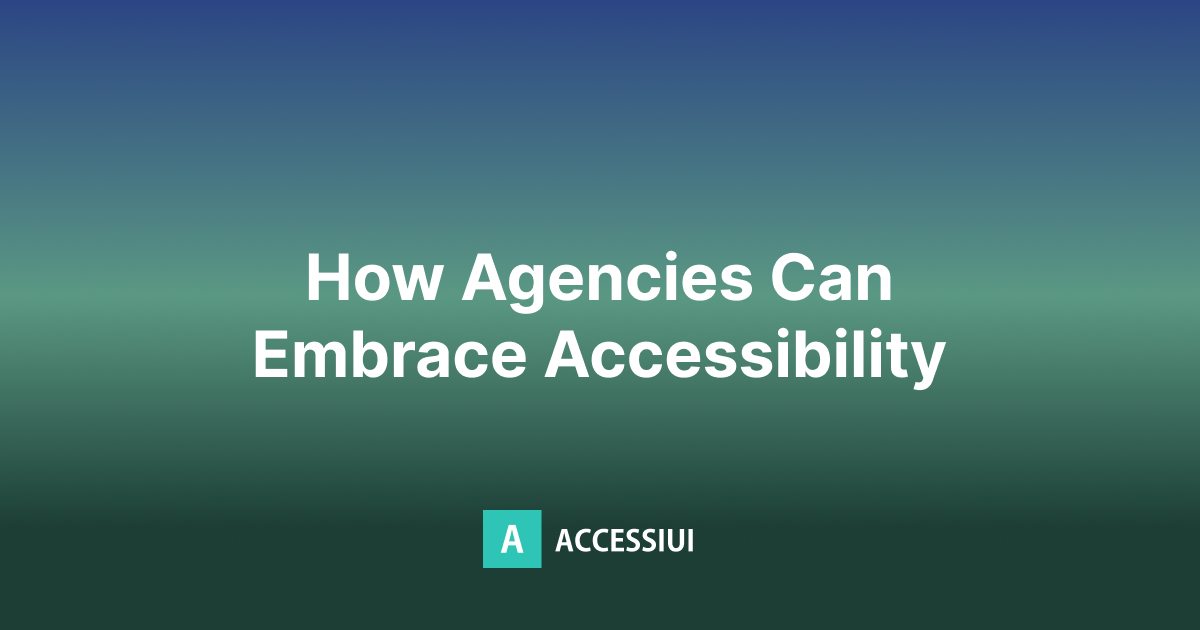Accessibility Is Now a Must-Have: Here’s How Agencies Can Keep Up
AccessiUI Team

Accessibility has shifted from a bonus feature to a core requirement in digital projects. Agencies must now deliver websites and apps that serve all users, including those with disabilities. This change is driven by legal demands and rising client expectations for inclusion. To keep up, agencies need to embed accessibility throughout their workflows and use accessibility compliance tools like AccessiUI to simplify compliance and stay competitive.
Why Accessibility Can’t Wait Anymore
Accessibility is no longer something agencies can delay. It is now a standard requirement and a legal obligation in many regions. New regulations like the European Accessibility Act and recent updates to the Americans with Disabilities Act have transformed expectations around digital inclusion.
Agencies are now expected to create digital experiences that are accessible to all users. This means accessibility must be considered from the very beginning of every project, not after launch, not during QA, but at the design table. Agencies that recognize this shift early position themselves to lead, not follow.
The Cost of Falling Behind
Agencies that neglect accessibility risk more than dissatisfied clients. They may face legal action, lose out on RFPs, or miss traffic from users unable to access their sites.
There’s also reputational damage. An inaccessible site signals that certain users were not considered. For agencies, that means the brand message is already compromised before the content is even read. Keeping up requires agencies to treat accessibility as an essential part of quality, not an afterthought.
What Clients Now Expect From Agencies
Today’s clients no longer ask whether accessibility matters; instead, they want to know how you plan to deliver it. They expect a solid understanding of the Web Content Accessibility Guidelines (WCAG), design that considers assistive technologies, and clear evidence of results.
Agencies that meet these expectations go beyond simply responding to accessibility requirements. They lead with accessibility by integrating it into every phase of the project. This approach builds trust with clients and helps win new business based on value, not just price.
Bringing Accessibility Into the Creative Process
Good accessibility starts before a single line of code is written. That includes using sufficient color contrast, choosing readable typefaces, ensuring interaction elements are intuitive, and structuring content to be screen-reader friendly.
Agencies can stay ahead by building internal processes that make accessibility reviews standard at every milestone. When accessibility becomes part of your design language, the end product feels natural, usable, and inclusive from the start.
Making Accessibility Scalable With the Right Tools
One of the most effective ways agencies can keep up is by adopting smart accessibility platforms. AccessiUI is built for this purpose. It helps teams identify accessibility issues early, correct them quickly, and monitor compliance continuously while fitting smoothly into your existing workflow.
With AccessiUI features, agencies gain access to automated code analysis, visual contrast feedback, and WCAG-aligned reporting. These tools help teams work more efficiently and keep up with constantly evolving compliance standards.
Turning Inclusion Into Competitive Advantage
Agencies that treat accessibility as a strategic priority rather than just a checklist item are better positioned for long-term success. Inclusive design shows care and attention. It also reflects a genuine commitment to delivering high quality work that reaches more users.
By embedding accessibility into your workflows and using tools like AccessiUI, you protect your clients while building a future-proof agency. This approach helps you win business, deliver meaningful impact, and lead with purpose.

